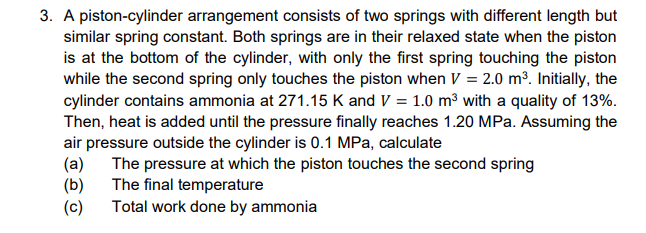3. A piston-cylinder arrangement consists of two springs with different length but similar spring constant. Both springs are in their relaxed state when the piston is at the bottom of the cylinder, with only the first spring touching the piston while the second spring only touches the piston when V = 2.0 m³. Initially, the cylinder contains ammonia at 271.15 K and V = 1.0 m³ with a quality of 13%. Then, heat is added until the pressure finally reaches 1.20 MPa. Assuming the air pressure outside the cylinder is 0.1 MPa, calculate (a) The pressure at which the piston touches the second spring The final temperature (b) (c) Total work done by ammonia
3. A piston-cylinder arrangement consists of two springs with different length but similar spring constant. Both springs are in their relaxed state when the piston is at the bottom of the cylinder, with only the first spring touching the piston while the second spring only touches the piston when V = 2.0 m³. Initially, the cylinder contains ammonia at 271.15 K and V = 1.0 m³ with a quality of 13%. Then, heat is added until the pressure finally reaches 1.20 MPa. Assuming the air pressure outside the cylinder is 0.1 MPa, calculate (a) The pressure at which the piston touches the second spring The final temperature (b) (c) Total work done by ammonia
Elements Of Electromagnetics
7th Edition
ISBN:9780190698614
Author:Sadiku, Matthew N. O.
Publisher:Sadiku, Matthew N. O.
ChapterMA: Math Assessment
Section: Chapter Questions
Problem 1.1MA
Related questions
Question
Please help me out.

Transcribed Image Text:3. A piston-cylinder arrangement consists of two springs with different length but
similar spring constant. Both springs are in their relaxed state when the piston
is at the bottom of the cylinder, with only the first spring touching the piston
while the second spring only touches the piston when V = 2.0 m³. Initially, the
cylinder contains ammonia at 271.15 K and V = 1.0 m³ with a quality of 13%.
Then, heat is added until the pressure finally reaches 1.20 MPa. Assuming the
air pressure outside the cylinder is 0.1 MPa, calculate
(a)
The pressure at which the piston touches the second spring
The final temperature
(b)
Total work done by ammonia
(c)
Expert Solution
This question has been solved!
Explore an expertly crafted, step-by-step solution for a thorough understanding of key concepts.
Step by step
Solved in 2 steps with 1 images

Knowledge Booster
Learn more about
Need a deep-dive on the concept behind this application? Look no further. Learn more about this topic, mechanical-engineering and related others by exploring similar questions and additional content below.Recommended textbooks for you

Elements Of Electromagnetics
Mechanical Engineering
ISBN:
9780190698614
Author:
Sadiku, Matthew N. O.
Publisher:
Oxford University Press

Mechanics of Materials (10th Edition)
Mechanical Engineering
ISBN:
9780134319650
Author:
Russell C. Hibbeler
Publisher:
PEARSON

Thermodynamics: An Engineering Approach
Mechanical Engineering
ISBN:
9781259822674
Author:
Yunus A. Cengel Dr., Michael A. Boles
Publisher:
McGraw-Hill Education

Elements Of Electromagnetics
Mechanical Engineering
ISBN:
9780190698614
Author:
Sadiku, Matthew N. O.
Publisher:
Oxford University Press

Mechanics of Materials (10th Edition)
Mechanical Engineering
ISBN:
9780134319650
Author:
Russell C. Hibbeler
Publisher:
PEARSON

Thermodynamics: An Engineering Approach
Mechanical Engineering
ISBN:
9781259822674
Author:
Yunus A. Cengel Dr., Michael A. Boles
Publisher:
McGraw-Hill Education

Control Systems Engineering
Mechanical Engineering
ISBN:
9781118170519
Author:
Norman S. Nise
Publisher:
WILEY

Mechanics of Materials (MindTap Course List)
Mechanical Engineering
ISBN:
9781337093347
Author:
Barry J. Goodno, James M. Gere
Publisher:
Cengage Learning

Engineering Mechanics: Statics
Mechanical Engineering
ISBN:
9781118807330
Author:
James L. Meriam, L. G. Kraige, J. N. Bolton
Publisher:
WILEY